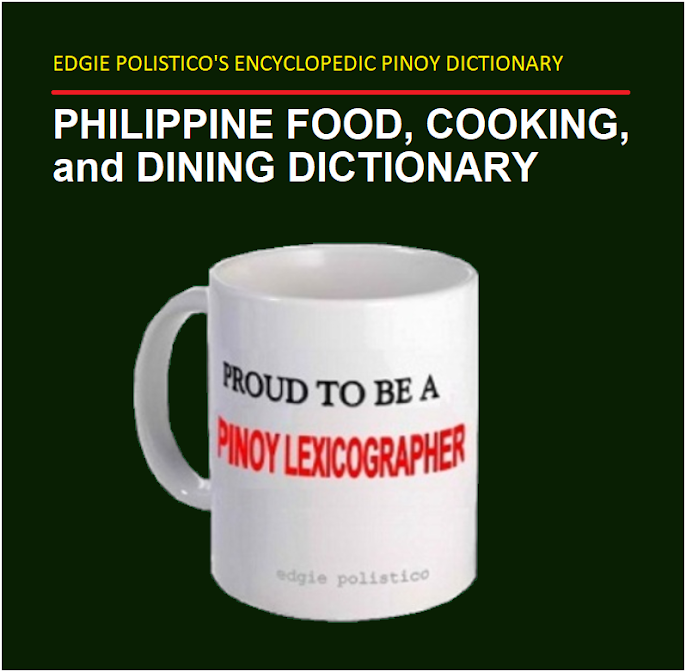
tarang bulan - /ta-ráng bu-lan/ Ta'u-sug snack; dw Bahasa Melayo tarang [bright] + Tausug bulan [moon]) [n.] bright moon pancake \stuffed folded golden pancake.
Other local name:
- Muslim hotcake in Chavacano [Zamboangueño]
A traditional pancake made with a runny batter of flour mixed with some water (or fresh milk), baking powder, sugar, and yellow-orange food color.

A Tausug lass selling tarang bulan in Zamboanga City public market.
A pan is pre-heated and brushed with butter (or margarine) on the surface. A scoop of the batter is poured on the pan and set to cook on medium fire until the batter formed into a round patty of pancake with bubbly perforation on its surface and smooth on the underside. The pancake is removed from the pan and the top side is spread with sweetened boiled mongo beans (mung beans) then folded halfway making it look like a half-moon.

When serving, the tarang bulan is sliced into parts.
This snack originated in neighboring Asian countries and can be found also in Indonesia and Malaysia.

Tausug tarang bulan in the corner of Zamboanga City's public market (2013)..
The name tarang bulan is from the Bahasa
Melayo tarang meaning "bright" and Tausug bulan meaning "moon." The shape and its bright yellow-orange
color are enough explanations for why this folded stuffed pancake is aptly called the bright moon.

What makes tarang bulang different from the usual pancake we have in other regions is that it has a spread of sweetened boiled mongo beans inside the fold.
Personal notes:
If you need to look for this in Metro Manila, don't go far, you can find them on weekends in Maharlika Village near the Blue Mosque.
If you prepare the pancake of tarang bulan by yourself, you can follow the way western pancake or the Tagalog and Visayan hot cake is done. Just make it way a lot bigger and thicker than those you found in the morning menu of Jollibee and McDo. You sprinkle the batter with a little amount of ground salt to make the patty pancake more savory. Adding a dash of cinnamon powder or droplets of vanilla extract would make the pancake lusciously aromatic. Boiled pandan leaf extract will do it too.
For the sweetened mongo beans, you can prepare them like the way minatamis na monggo is done for the traditional summer halo-halo or of pan de mongo and hopia monggo. It's the same sweetened mongo you can find stuffed in ensaymadang monggo.
If you're fed up with mung beans all your life or afraid of having gout pains later in your joints, you can vary the fillings. Instead of sweetened mung beans, use haleyang ube, strawberry jam (from Benguet), minatamis na buko or macapuno, peanut butter, cheese, omellete, chocolate spread, or leche flan.
If you're fed up with mung beans all your life or afraid of having gout pains later in your joints, you can vary the fillings. Instead of sweetened mung beans, use haleyang ube, strawberry jam (from Benguet), minatamis na buko or macapuno, peanut butter, cheese, omellete, chocolate spread, or leche flan.
For fresh milk, you can substitute it with milk powder mixed with water. Try kakang gata, it will do wonder too.
Related posts:
All photos by Edgie Polistico in this blog are copyrighted. ALL RIGHTS RESERVED.
See Index of Entries here.
If you liked this post, share it.
Let us know your opinion on the subject. Feel free to comment in the comment section, below. It is important for us to know what you think.
Tell us what other topics you would like us to write, share, and discuss.
Continue to follow my blogs. You can also follow and learn more by joining us in our Facebook group account of Philippine Food Illustrated (Private) and Philippine Food Illustrated (Public). It is my pleasure to rediscover the known and least known things or the unheard ones and put them here for everyone to find, learn, and treasure.
Thank you for all the encouragement and enthusiasm. I need also moral support, prayers, and anything else that can uplift my spirit and keep my good reasons.
If you are pleased or happy with this blog, please share the PHILIPPINE FOOD ILLUSTRATED. It is energizing that my blog is shared with others.
Edgie Polistico
For more about Filipino food, see this Philippine Food, Cooking, and Dining Dictionary. It is OPEN and FREE.









